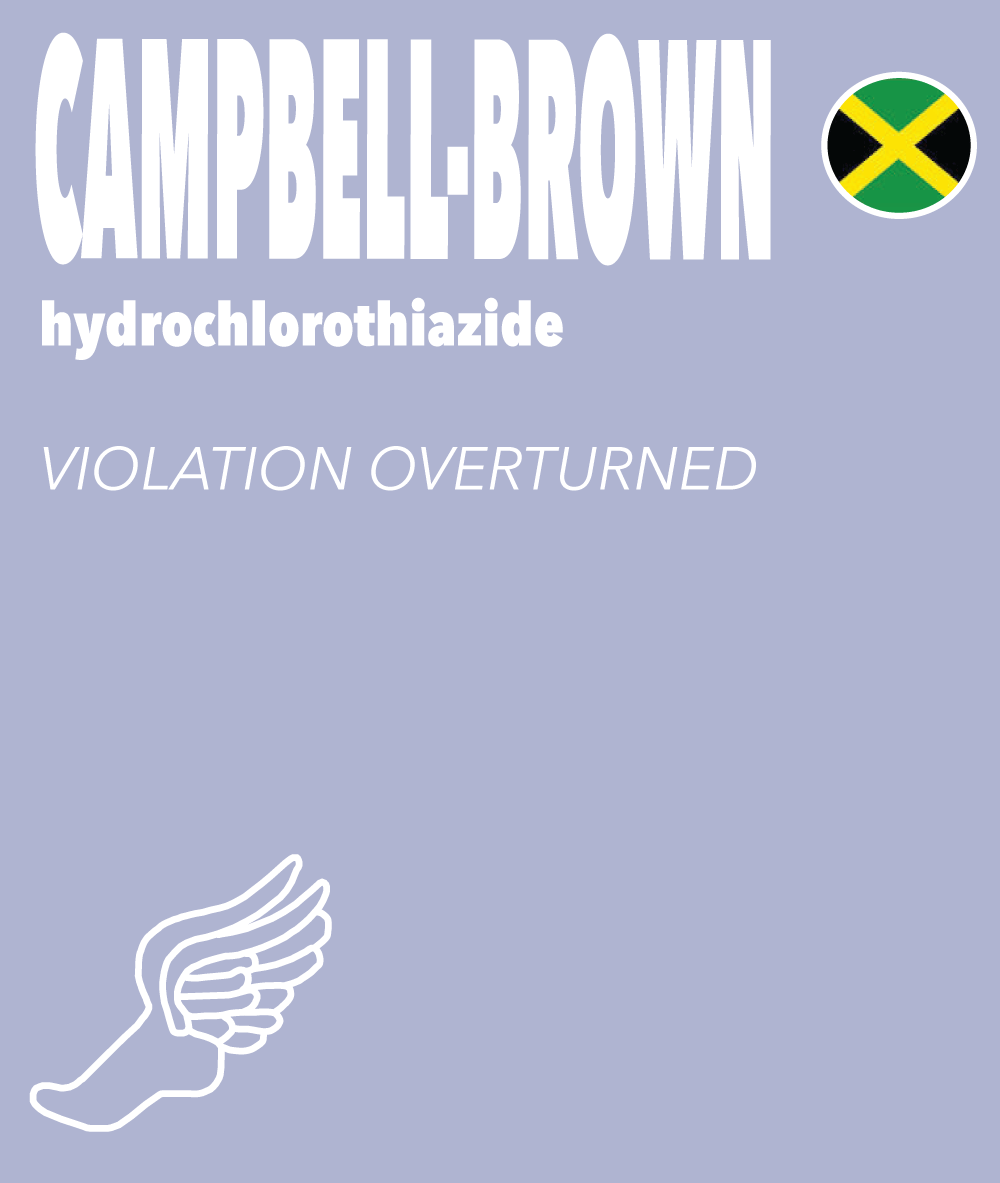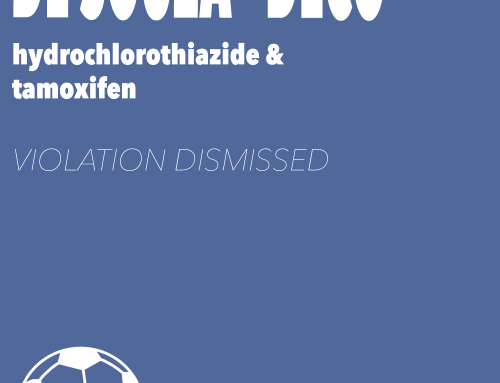Download the Campbell-Brown Blog Post HERE
CAS Award: Veronica Campbell-Brown v. The Jamaica Athletics Administrative Association (JAAA) & The International Association of Athletics Federations (IAAF), CAS 2014/A/3487, February 24, 2014.
Keywords: International Standard for Testing, procedural departures, causality requirement
This award is significant in that it is among the first published awards to delve into the “causality” requirement in Article 3.2 of the WADA Code, which confirms that procedural defects should only invalidate an anti-doping rule violation if they were material to the outcome of the analysis process. While there are several important findings in this award, the overarching theme can be summarized in the CAS Panel’s expression of the principle of “quid pro quo”: given the harshness of the WADA Code regime on Athletes, ADOs must be held to the same strict standards for adherence to their rules, including technical rules of procedure put in place to protect the integrity of Doping Control. The award conveys a strong message to the anti-doping movement that the credibility of the procedures is a key component of Doping Control and makes it clear that Anti-Doping Organizations who systematically fail to adhere to applicable standards may not seek refuge behind evidentiary advantages granted by the WADA Code.
The Main Findings of the Award
– The main rationale underlying the mechanics of the regime applicable to procedural defects in the WADA Code is a “quid pro quo” argument: since Athletes are held to very strict standards of liability, ADOs must be equally strict in adhering to their rules.
– There is a CAS line of decisions recognizing certain safeguards as so fundamental to the integrity of the process that a breach of these safeguards always invalidates the Adverse Analytical Finding, without regard to causality considerations (e.g. the right to attend the B Sample analysis).
– For all other defects, the requirement that the departure caused the Adverse Analytical Finding must be interpreted in a broad manner, encompassing all defects that create an opportunity for an intervening act to compromise the integrity of the Sample.
– The Athlete only needs to show the reasonable possibility of a causative link, which means that the standard is lower than a balance of probability. The causative link must appear at least plausible, more than merely hypothetical, but need not be likely.
– Once the Athlete has discharged this burden, the burden shifts in full to the ADO to establish the lack of causality. This burden must be assessed in a particularly severe manner in case of systematic defects showing a lack of willingness of the ADO to organize its doping control process in accordance with the standards.
The Facts of the Case
Veronica Campbell-Brown, a Jamaican sprinter underwent an In-Competition Test after the 100m Event at the Jamaica Invitational Meet in Kingston, Jamaica. Several procedural anomalies occurred during Sample collection. The sprinter was unable to provide a full urine sample on the first attempt, which should have spurred the doping control officer (DCO) to use a special device and process for collecting partial Samples, which was not done. Additionally, the partial Sample did not stay under the control of the DCO as provided for in the applicable IAAF rules. Instead, the unsealed partial Sample was given directly to the Athlete, who left it unattended on more than one occasion while she was waiting to be able to complete Sample collection. Finally, the DCO failed to complete a box on the form that must be filled in whenever an Athlete provides a partial Sample.
The analysis returned a positive finding for a very small amount of Hydrochlorothiazide (HCT), a diuretic prohibited as a Specified Substance, and its metabolite chloraminophenamide. Despite testing the supplements and ointments used on a regular basis, Veronica Campbell-Brown was unable to establish the source of the substance. As part of her defense, she submitted to a lie detector test, which concluded that she had never used HCT or any other Prohibited Substance. In addition, the Athlete solicited expert testimony which addressed the possibility of Sample contamination. According to the expert, three samples out of the one hundred that were taken at the same Event location in May and June of 2013 contained the substance HCT (which was significantly higher than the 0.05% rate of positive samples for HCT worldwide in 2012), two of which were confirmed to be partial samples (it was not known whether the third sample was a partial sample). While one of the experts who submitted testimony for the Athlete in this case opined that it was “unlikely, but possible” that the sample could have been contaminated with sweat or water containing HCT, he also concluded that it was “possible…but unlikely” that these three positive Samples were coincidental. Instead, he suggested that the three positive samples were “suggestive” of a common environmental cause.
The Significance of the “Causality” Requirement for Procedural Defects
The main issue that the Panel considered in this case, which implicates quite a number of interesting procedural sub-issues, is whether the ADO discharged its burden in establishing an anti-doping rule violation. The Panel started its analysis by interpreting rule 33.3(b) of the IAAF rules (which is based on Article 3.2 of the WADC) and sets forth the methods for establishing facts and presumptions. Specifically, Article 3.2.2 provides that if an Athlete
“establishes that a departure from another International Standard or other anti-doping rule or policy has occurred which could reasonably have caused the Adverse Analytical Finding…then the [ADO] shall have the burden of establishing that such departure did not cause the Adverse Analytical Finding…” (emphasis added).
With respect to the phrase “could reasonably have caused,” the Panel noted at the outset that it is “relatively rare” that a departure from the International Standard for Testing (IST) would directly cause an Adverse Analytical Finding; rather, the focus of the inquiry should be on whether such a departure opened an opportunity for an “intervening act” (such as sabotage or contamination) to occur.
To stage its analysis, the Panel made two significant observations. First it noted that there is “considerable force” in past CAS jurisprudence supporting the notion that this rule provides an appropriate counter balance or “quid pro quo” for the principle of strict liability. In other words,
“in order to justify imposing a regime of strict liability against athletes for breaches of anti-doping regulations, testing bodies should be held to an equivalent standard of strict compliance with mandatory international standards of testing.”
Second, the Panel recognized that certain aspects of the International Standards “are considered to be so fundamental to the fairness of the doping control regime and so central to ensuring the integrity of the sample collection and testing process that any departure from them will result in the automatic invalidation of the outcome of the testing procedure.” As an example, the Panel recalled several past CAS cases regarding the Athletes’ right to attend the B sample analysis.
The next aspect that the Panel considered was the standard of proof for the Athlete to establish that a departure from the IST could reasonably have caused an Adverse Analytical Finding. Rejecting the IAAF’s argument that the relevant standard should be a balance of probability, the Panel instead held that the
“causative link must be more than merely hypothetical, but need not be likely, as long as it is plausible.”
The Panel noted that this standard strikes the appropriate balance between the interests at play, namely: “the rights of athletes to have their samples collected and tested in accordance with mandatory testing standards, and the legitimate interest in preventing athletes from escaping punishment for doping violations on the basis of inconsequential or minor technical infractions.” Due to the automatic consequences stemming from an Adverse Analytical Finding, any possibility for Sample contamination should be subject to “the most anxious scrutiny.” Mandatory standards for Sample collection are in place precisely to eliminate the possibility that such contamination might occur. The Panel confirmed the consistency of their interpretation with previous cases that also sought to exclude “inconsequential IST departures from the scope of burden shifting provisions.”
The Impact of Systematic Non-Adherence to Procedural Standards
The Panel then turned to the facts of the case, i.e. whether the Athlete had successfully established a “material – as opposed to merely theoretical – possibility of sample contamination” In other words, the Panel asked whether it would be reasonable to assume that the admitted departure from the IST could have caused the presence of HCT in the Athlete’s sample. The distinguishing point in this case as compared to former CAS decisions seems to be that Athletes are expected to be somewhat proactive in presenting actual scientific evidence that there could be a causal link between the presence of the Prohibited Substance in the Sample and the departure from the IST, rather than relying on mere speculation. In this case, the Panel seemed particularly swayed by the Athlete’s expert’s statistical view of the evidence. Further, the Panel firmly refused that the Athlete should be prejudiced by the JAAA’s inadequacies in accurately collecting data (i.e. consistently failing to indicate on the doping control form whether the Sample was a partial Sample) that would have enabled the Panel to better evaluate the statistical significance of such evidence. Accordingly, the Panel held that the admitted departure from the IST could indeed be deemed to have reasonably caused the positive test.
With the burden of proof shifted back onto the ADO to show a lack of causative link or otherwise establish the anti-doping rule violation, the Panel concluded that that it was not comfortably satisfied that the Athlete committed an anti-doping violation. Significantly, in a rather forceful section of the award, the Panel set forth that the ADO’s burden for establishing an anti-doping rule violation is
“substantially higher where the anti-doping body has engaged in a knowing, systematic and persistent failure to comply with a mandatory IST that is directed at the integrity of the sample collection and testing process.”
The Panel reiterated that the failure of the ADO to diligently uphold its strict standards in sample collection and testing necessarily attenuates “their ability to hold athletes to that strict standard of accountability.” The Panel continued on this line by chiding the JAAA for its unexplained “systematic and knowing failure” to follow the necessary protocol, labeling its deficiency as “deplorable” and noting that it “giv[es] rise to the most serious concerns about the overall integrity of the JAAA’s anti-doping processes.” Finally the Panel considered the Athlete’s testimony to be “detailed and materially consistent.” The Panel did not place particular weight on the polygraph evidence. It did note, however, that while the Athlete’s denial of intentionally consuming HCT does not in itself affect the likelihood of inadvertent ingestion, it was a “further factor” considered in reaching the conclusions in the award.
(copyright May 24, 2014)





Leave A Comment